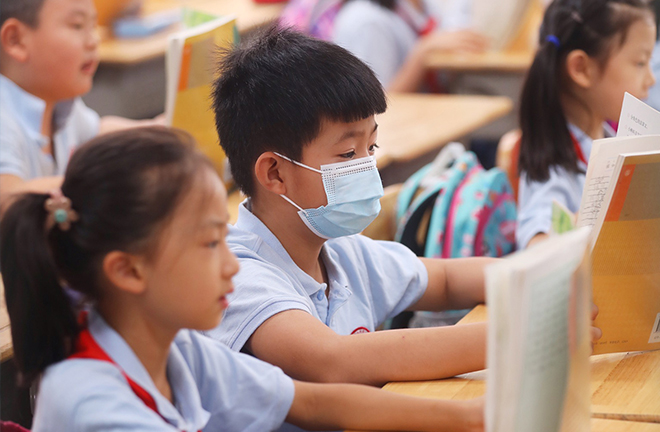‘Double reduction’ should address both symptoms and causes

“Double reduction” policy is implemented in China in the context that students face an excessively heavy burden of homework and off-campus tutoring. Photo: Yang Bo/CNS
Since the General Office of the CPC Central Committee and General Office of the State Council jointly issued the Opinions on Further Reducing the Burden of Excessive Homework and Off-Campus Tutoring for Students Undergoing Compulsory Education, implementation of the “double reduction” policy has become the most noteworthy issue in the education sector.
Root causes of anxiety
How does anxiety in education arise? This is the fundamental question that needs to be considered when advancing the “double reduction” policy. In the stage of compulsory education, sources of anxiety include schools, teachers, parents, and students, among which the most important are parents as guardians of students. Schools and teachers care deeply about reputation and rankings, but not as deeply as parents care about giving their children a bright future.
Education plays an increasingly crucial role in social stratification—this is a deeply entrenched common belief among parents based on their long-term observations and conclusions. Therefore, under the influence of the idea that “it’s the fault of the father or the mother if their children are not well-educated or well-mannered,” parents are racking their brains to help their children achieve higher scores and obtain opportunities for better development. It will dash their hopes if their children lag at the educational starting line, which would mean a lower status among their social stratification levels in the future.
Therefore, the root causes of educational problems often lie outside the education system. On the surface, it seems that some of the problems occur in the education sector, but mere institutional reform within education systems can only “cool down the heat” but cannot “extinguish the fire.” In the process of implementing the “double reduction” policy, coerced regulation of students’ homework and institutions that carry out tutoring cannot uproot the long-standing educational problems in a radical way.
For many years, it was social consensus that civil servants, CEOs, financial sector elites, artists, lawyers, and software designers, are jobs with high value and high social status, while mining, manufacturing and processing, sales and service, belong to high-cost but low-reward industries. Therefore, parents hope that their children obtain an “iron bowl” or a “golden bowl” job which can ensure stable and high salaries. The idea that “he who excels in learning can obtain official government posts” still has solid social foundations in today’s China. Due to the existence of social stratification, it is difficult to fundamentally alter stereotyped mentalities and actions of parents based solely on efforts from administrative departments in the education sector, and didactic persuasion from experts, scholars, and mass media.
When education only determines students’ knowledge composition and focuses on exploring students’ interests and specialties, but no longer determines students’ future social status and access to resources, the implementation of the “double reduction” policy can gather extensive participation from all social players.
Reforming vocational education
The student division based on zhongkao (the high-school entrance examination), which divides middle-school students into general academic high-schools and secondary vocational institutions, is the direct cause for parents’ anxiety about education. In recent years, the term “zhongkao division determines one’s whole life” has become more and more common. Low enrollment numbers for general academic high-schools has exacerbated anxiety for parents and students.
In addition, China implements a “two-track” educational system in which vocational education and academic education run parallel to one another. However, the two tracks diverge, especially as vocational education is relatively enclosed, and entrance into vocational middle-schools and high-schools means the termination of education opportunities, being labeled as only eligible for inferior occupations, and low social status.
Given such educational circumstances, parents must plan in advance to help students gain the upper hand in fierce competition for enrollment in general academic high-schools. Heavily loaded, primary and middle-school students, and even infants, are prematurely pushed into the fervor of harsh competition, which leads to distortion of students’ social psychology and the divergence of educational functions.
The gaokao (university entrance examination) is another key gateway for students. After they pass the zhongkao barrier, and enter general academic high-schools, they still face fierce competition. In 2020, the gross enrollment rate into higher education in China reached 54.4%, which means that traditional problems of students accessing higher education opportunities have been basically solved. But entering different universities means preparing students differently. Education needs thus to be planned from the source. Measures can include establishing more general academic high-schools, expanding the size of undergraduate vocational colleges, and paving more ways for vocational high-school students to continue their studies.
Optimizing subjects of examination
To implement the “double reduction” policy, departments in the educational system need to take stringent measures to produce real effects. The evaluation system is the measuring stick for educational reform, and “what is tested, what is learned” is the doctrine that generally guides the actions of parents.
Therefore, the subjects of examination should be optimized in a fundamental way. Reasonable examination subjects and content should adapt to the progress of the times. Based on the realistic needs of cross-disciplinary knowledge penetration and scientific and technological innovation, some scholars have proposed dividing the subjects of examinations into mega-science, mega-humanity, mega-history, and other fields. In view of this, an effective way to solve the basic problem of “what to reform and how to reform” is by organizing experts and teams to redesign and re-plan the proportions of different subjects for all types of entrance examinations.
Zhang Haijun (professor) and Wang Zhiqiang are from the National Institute of Education Sciences and Guangdong Academy of Education, respectively.
Edited by BAI LE
